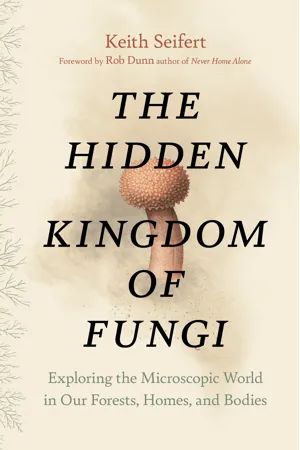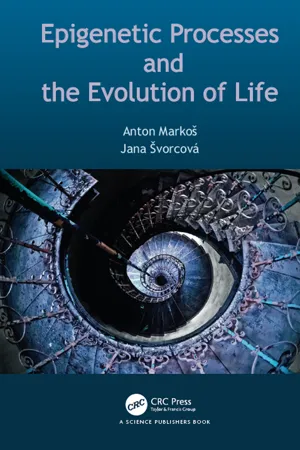Biological Sciences
Lichens
Lichens are symbiotic organisms formed from a partnership between a fungus and a photosynthetic partner, usually algae or cyanobacteria. They are found in diverse habitats and play important ecological roles, such as contributing to soil formation and serving as a food source for various organisms. Lichens are also used as bioindicators of environmental quality due to their sensitivity to pollution.
Written by Perlego with AI-assistance
Related key terms
2 Key excerpts on "Lichens"
- eBook - ePub
The Hidden Kingdom of Fungi
Exploring the Microscopic World in Our Forests, Homes, and Bodies
- Keith Seifert(Author)
- 2022(Publication Date)
- Greystone Books(Publisher)
When we consider this abundance, and all the interactions that might happen between any pair of species, the complexity of nature becomes clearer. Symbiotic relationships between fungi and other organisms challenge our preconceptions about individuality and the patterns of evolution. Lichens: Mutualistic Fungus-Plant Symbiosis Sudbury became famous for its Lichens when I was a boy. The nickel smelters were the world’s largest point source of sulfur dioxide, that gas notorious for its rotten-egg smell. The treeless terrain around the city was sprinkled with hundreds of unnaturally crystal-clear lakes acidified by pollution. After the Superstack became operational, remediation of the landscape began. Work crews strewed lime to reduce the acidity of the soils and planted tolerant grasses and shrubs. Teams of summer student researchers monitored buildings, rocks, and trees for the return of lichen species sensitive to sulfur dioxide. The changes in their abundance were early indicators that the contaminated landscape was recovering. Lichens are still used for monitoring air pollution around cities. 3 But what are these strange organisms? Once you think to look around for them, Lichens seem to be everywhere. If you explore along shorelines, you will see the spreading yellow and green crusts clutching on to rocks. Follow a path through the forest, and other Lichens are glued to tree bark or festooned over branches. In cities, they spread on the stone walls and roofing tiles of old buildings. When you pick up a lichen, it is dry, tough, and leathery. The lichen body, known as a thallus (pl. thalli), is a dense felt of fungal hyphae. With a magnifying glass, the surface looks like a macabre landscape from a painting by Hieronymus Bosch. Monolithic columns and wobbly gall-like growths are littered over the crust. These are clusters or bundles of fungal hyphae coiled around algal cells. They break off like skin tags - eBook - ePub
- Jana Švorcová, Anton Markoš(Authors)
- 2019(Publication Date)
- CRC Press(Publisher)
(ii) There also exists very intimate cohabitations of partners who, however, remain all the time ‘for self’, thoroughly maintaining their cell closures. Such is the case of Lichens, of mycorrhiza and of endophytic fungi. In protists, an intimate symbiosis of a unicellular alga with nitrogen-fixing non-photosynthesizing cyanobacterium may serve as an example (Thompson et al. 2012). Bacterial ecosystems like mats, sediments, etc., also can harbor groups of organisms intimately connected through their way of living.(iii) Tentatively, we introduce to our list some cases of mimicry and imitation. Such phenomena can be defined as extreme mutual morphogenetic coupling—based again on understanding some external cues—of organisms belonging to different lineages.Here we present three ‘typical’ examples of symbiosis as known to general public: fungus-plant partnership, animal-bacterium symbiosis, and intracellular symbiosis.On Lichens, Squids, and Coral Bleaching(1) Lichens have been mascots of symbiotic interactions since the 19th century. This kind of symbiosis of a fungus with an alga or cyanobacterium has become a textbook example, and need not be discussed here in detail. The intimacy of cohabitation earned the creatures even a distinguished position in the system of organisms. Even if intimate symbioses abound everywhere, probably only Lichens invented a special form of hand-in-hand propagation of both partners. It came as a recent surprise that Lichens can contain in their cortex even a third partner—a yeast, living in a stable symbiosis with the ‘dominant’ fungus and alga (Spribille et al. 2016). In the light of such findings, less known symbiotic assemblages may bring even more surprises. Both fungi and plants are apparently prone to a mutual symbiosis: Hom and Murray (2014) describe relatively easy establishment (in the laboratory) of mutualist cohabitation of yeasts or even hyphal fungus, with a unicellular alga. It must be more sophisticated in the case of, say, mycorrhiza, lasting for some 400 millions of years (see below).
Learn about this page
Index pages curate the most relevant extracts from our library of academic textbooks. They’ve been created using an in-house natural language model (NLM), each adding context and meaning to key research topics.

